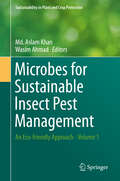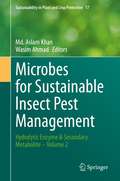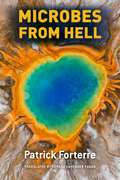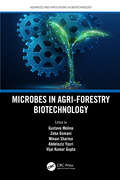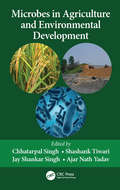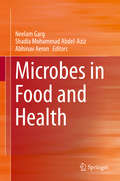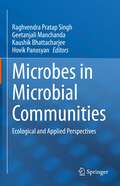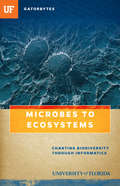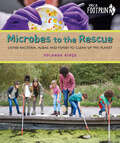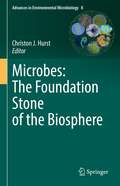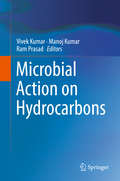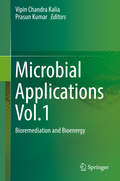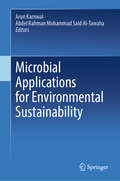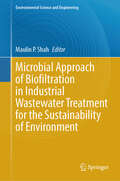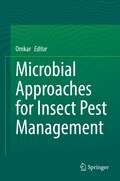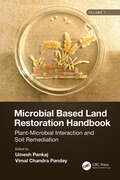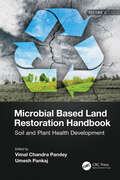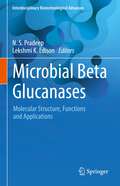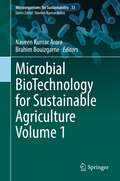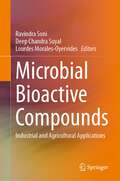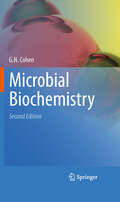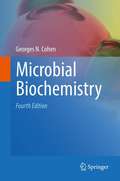- Table View
- List View
Microbes for Sustainable Insect Pest Management: An Eco-friendly Approach - Volume 1 (Sustainability in Plant and Crop Protection)
by Md. Aslam Khan Wasim AhmadThis Volume comprises 14 chapters in an attempt to provide the reader with available information on safe and effective use of entomopathogens. Chapters in this book dealing with soil-borne entomopathogens and their phylogeny also provide a review on most updated information of their isolation and molecular identification. Employing fungal pathogens in biological control programmes plays a key role, and conidial thermotolerance and oxidative stress are examined in separate chapters. Entomopathogenic bacteria are able to kill their hosts quickly. An important contribution concerns informations provided upon bacterial cytotoxic factors on insect haemocytes. Nematodes are biological control agents safe to the environment. The information with respect to their direct and indirect effects on non-target organisms is provided. Viruses as highly specific, virulent candidates for use as biological insecticides are safe to non-target species. A separate chapter on the role of granuloviruses in IPM contributes a wealth of information. Biopesticides in combination with synthetic insecticides are reported as effective, economic, and eco-friendly. Understanding their interactions will certainly promote their uses. Finally, emphasis has been given on reviewing synergistic and antagonistic interactions of microbial and chemical pesticides, in other chapters.
Microbes for Sustainable lnsect Pest Management: Hydrolytic Enzyme & Secondary Metabolite – Volume 2 (Sustainability in Plant and Crop Protection #17)
by Md. Aslam Khan Wasim AhmadThe search for new strategies of pest control with safer molecules is currently of great importance and interest. Microbe-mediated biological crop protection is an attractive and promising technology with no concern for a negative impact on the environment and biodiversity. Microbial hydrolytic enzymes such as proteases, chitinases, lipases, etc. are attractive for this purpose. They present toxic properties and act synergistically to control pest attacks. Also, some metabolites, that microorganisms produce for their survival or defense, can be explored and exploited for plant protection. The focus of this Volume is on the potential of microbial hydrolytic enzymes and their metabolites in agroecosystem functioning. Subsequent chapters review topics such as microbial hydrolytic enzymes as powerful management tools, chitinases in IPM of agro-horticultural crops, metabolites as pesticides and the importance of the metabolites of entomopathogenic fungi, metabolites and virulence factors. Other topicas include: microbial-based nanoparticles, recombinant DNA technologies to improve the efficacy of microbial insecticides, the effects of entomopathogens on insect predators and parasitoids, and the management of major vegetable insect pests. This Volume provides detailed accounts on the safe use of microbial products for sustainable management of insect pests. Its aim is to build solid foundations for the students, teachers, and researchers interested in eco-friendly management of important insect crop pests.
Microbes from Hell
by Teresa Lavender Fagan Patrick ForterreAt the close of the 1970s, the two-domain classification scheme long used by most biologists--prokaryotes versus eukaryotes--was upended by the discovery of an entirely new group of organisms: archaea. Initially thought to be bacteria, these single-celled microbes--many of which were first found in seemingly unlivable habitats like the volcanic hot springs of Yellowstone National Park--were in fact so different at molecular and genetic levels as to constitute a separate, third domain beside bacteria and eukaryotes. Their discovery sparked a conceptual revolution in our understanding of the evolution of life, and Patrick Forterre was--and still is--at the vanguard of this revolution. In Microbes from Hell, one of the world's leading experts on archaea and hyperthermophiles, or organisms that have evolved to flourish in extreme temperatures, offers a colorful, engaging account of this taxonomic upheaval. Blending tales of his own search for thermophiles with discussions of both the physiological challenges thermophiles face and the unique adaptations they have evolved to live in high-temperature environments, Forterre illuminates our developing understanding of the relationship between archaea and the rest of Earth's organisms. From biotech applications to the latest discoveries in thermophile research, from microbiomes to the communities of organisms that dwell on deep-sea vents, Forterre's exploration of life-forms that seem to thrive at the mouth of hell provides a glimpse into the early days of Earth, offering deep insight into what life may have looked like in the extreme environments of our planet's dawn.
Microbes in Agri-Forestry Biotechnology (Advances and Applications in Biotechnology)
by Vijai Kumar Gupta Gustavo Molina Minaxi Sharma Zeba Usmani Abdelaziz YasriThis book explores recent advances on the use of microbes for agri-forestry biotechnological applications. It provides technical concepts and discussions on the use of microorganisms for processes such as bioprocessing, bioremediation, soil enhancement, aquaponics advances, and plant-host symbiosis. The book provides an overview of the microbial approach to the tools and processes used in agriculture and forestry that make or modify products, improve plants for specific uses, and make use of livestock in agricultural systems. The authors discuss the main process conditions that enhance agri-forestry applications with the use of microbes and introduce the use of genetically modified (GM) microbes in agrobiotechnology. Finally, the authors explore the main technological advances in the production of secondary metabolites with potential applications in agri-forestry. This book is intended for biotechnologists, biologists, bioengineers, biochemists, microbiologists, food technologists, enzymologists, and related researchers.
Microbes in Agriculture and Environmental Development
by Chhatarpal Singh, Shashank Tiwari, Jay Shankar Singh and Ajar Nath YadavThe collection of essays in Microbes in Agriculture and Environmental Development explores the applications of microbes for the improvement of environmental quality and agricultural productivity through inoculants and enzymes. These are useful for the conservation and restoration of degraded natural and agricultural ecosystems, crop yield extension, soil health improvement, and other aspects of agriculture and the environment. It discusses the effective use of microbial technology, wastewater treatment, and recycling of agricultural and industrial wastes. It provides detailed accounts of recent trends in microbial application in plant growth promotion, soil fertility, microbial biomass and diversity, and environmental sustainability through bioremediation, biodegradation, and biosorption processes Features: Discusses microbes and their applications for sustainable agriculture and environmental protection in agro-environmental circumstances Presents innovative and eco-friendly approaches for the remediation of contaminated soil and wastewater Focuses on green technologies and sustainability Includes chapters on sustainable agriculture development through increasing soil fertility, physico-chemical properties and soil microbial biomass in nutrient-deprived soils Defines the role of microbial bio formulation-based consortia in the productivity improvement of agricultural crops It will be an invaluable addition to the bookshelves of researchers and graduate students in agriculture and environmental engineering, soil science; microbiology, sustainable agriculture, and ecosystems. Dr. Chhatarpal Singh is presently the President of Agro Environmental Development Society (AEDS), Majhra Ghat, Rampur, Uttar Pradesh, India. Dr. Tiwari is currently working in the field of methanotrophs ecology (methane oxidizing bacteria), which is sole entity responsible for the oxidation of potent greenhouse gas CH4. Dr. Jay Shankar Singh is presently working as a faculty member in the Department of Environmental Microbiology at Babasaheb Bhimrao Ambedkar University in Lucknow, India. Dr. Ajar Nath Yadav is currently serving as an assistant professor in the Department of Biotechnology, Akal College of Agriculture, Eternal University, Baru Sahib, Himachal Pradesh, India.
Microbes in Food and Health
by Neelam Garg Shadia Mohammad Abdel-Aziz Abhinav AeronThis book gives an overview of the physiology, health, safety and functional aspects of microorganisms present in food and fermented foods. A particular focus is on the health effects of probiotics and non-dairy functional foods. The book deals also with microbes that cause food spoilage and produce toxins, and the efficiency of edible biofilm in the protection of packaged foods. Several chapters are devoted to the occurrence of Listeria pathogens in various food sources. Further topics are fortified foods, the role of trace elements, and the preservation of food and extension of food shelf life by a variety of measures.
Microbes in Microbial Communities: Ecological and Applied Perspectives
by Hovik Panosyan Raghvendra Pratap Singh Geetanjali Manchanda Kaushik BhattacharjeeThe book overviews the complex interactions amongst the microbes and their possible applications. Emphasis has been made to include a wide spectrum of experimental and theoretical contributions from eminent researchers in the field. Microbial communities are the assemblages of microorganisms of various species which live together in the same environment and continuously interact with each other. The microbial cells in communities display unique phenotypes that affect the survival and reproduction of other cells present around them. These phenotypes constitute the social adaptations that drive the interactions between microbial cells. The interactions, further determine the productivity, stability and the ability of community to resist the environmental perturbations. These microbial communities live with extremely competitive niche and fight for their survival and genetic persistence. But they frequently appear in niche with multifaceted and interactive webs rather than the planktonic nature. This can be within the same species or with different species, or even with diverse genera and families. It either a competitive winner community whereas the “weaker” strain goes extinct or a competitor that coexist with their metabolic secretory potentials or a separator that assigned their own community territorial niches. Sometimes, it can be neutral or tritagonist. These microbial associations within the microbiome provides the foundation for diverse forms of microbial ecology and determined the applied perspectives for agriculture, clinical and industrial sectors. This book will be useful to postgraduate students, researchers from academic as well as industry working in the field of microbial exploration with keen interest in survival factors and mechanism of their survival by various ecological and functional strategies.
Microbes to Ecosystems: Charting Biodiversity through Informatics
by University of Florida Blake D. EdgarThe University of Florida has an ambitious goal: to harness the power of its faculty, staff, students, and alumni to solve some of society’s most pressing problems and to become a resource for the state of Florida, the nation, and the world. In Microbes to Ecosystems, follow the scientists, researchers, and staff of the University of Florida’s Biodiversity Institute as they marshal unprecedented amounts of biological data to help us conserve species, adapt to climate change, and solve pressing environmental problems. With a twenty-first-century, interdisciplinary approach, the Biodiversity Institute unites some of the most prominent researchers and state-of-the-art resources in the biological sciences, genomics, and informatics. Together they innovate new methods and technologies to accelerate discovery, communicate data and understanding, and determine potential solutions for maintaining sustainable environments. Connections are critical to both ecological and computational systems, and the institute aims to build connections that can help us more effectively study and save biological diversity, including connecting perspectives between the natural sciences and social sciences and connecting scientific research to regulatory policy. Central to the institute’s efforts is the Florida Museum of Natural History—the second largest university-based natural history museum in the country and home to more than 40 million specimens and artifacts—and iDigBio, the national center for creating a digital catalog of the earth’s flora and fauna. The stories chronicled in Gatorbytes span all colleges and units across the UF campus. They detail the far-reaching impact of UF’s research, technologies, and innovations—and the UF faculty members dedicated to them. Gatorbytes describe how UF is continuing to build on its strengths and extend the reach of its efforts so that it can help even more people in even more places.
Microbes to the Rescue: Using Bacteria, Algae and Fungi to Clean Up the Planet (Orca Footprints)
by Yolanda RidgeMicrobes are tiny but mighty, and they're everywhere! When left alone, microbes such as bacteria, fungi and algae are experts at adapting, surviving and thriving under extreme and constantly changing conditions. These natural problem solvers can help fight the climate crisis by gobbling up pollutants, breaking down plastic, generating clean energy and capturing carbon. By harnessing the power of microbes, we can create eco-friendly packaging, farm-free food, and even make it easier to live in space! Microbes to the Rescue will introduce young readers to life on a microscopic level and explore how bacteria, fungi and algae play a key role in the connection between all life on Earth. Let’s get microscopic and learn about how microbes can create a cleaner and more sustainable future. The epub edition of this title is fully accessible.
Microbes: The Foundation Stone of the Biosphere (Advances in Environmental Microbiology #8)
by Christon J. HurstThis collection of essays discusses fascinating aspects of the concept that microbes are at the root of all ecosystems. The content is divided into seven parts, the first of those emphasizes that microbes not only were the starting point, but sustain the rest of the biosphere and shows how life evolves through a perpetual struggle for habitats and niches. Part II explains the ways in which microbial life persists in some of the most extreme environments, while Part III presents our understanding of the core aspects of microbial metabolism. Part IV examines the duality of the microbial world, acknowledging that life exists as a balance between certain processes that we perceive as being environmentally supportive and others that seem environmentally destructive. In turn, Part V discusses basic aspects of microbial symbioses, including interactions with other microorganisms, plants and animals. The concept of microbial symbiosis as a driving force in evolution is covered in Part VI. In closing, Part VII explores the adventure of microbiological research, including some reminiscences from and perspectives on the lives and careers of microbe hunters.Given its mixture of science and philosophy, the book will appeal to scientists and advanced students of microbiology, evolution and ecology alike.
Microbia: A Journey into the Unseen World Around You
by Eugenia BoneFrom Eugenia Bone, the critically acclaimed author of Mycophilia, comes an approachable, highly personal look at our complex relationship with the microbial world. While researching her book about mushrooms, Eugenia Bone became fascinated with microbes—those life forms that are too small to see without a microscope. Specifically, she wanted to understand the microbes that lived inside other organisms like plants and people. But as she began reading books, scholarly articles, blogs, and even attending an online course in an attempt to grasp the microbiology, she quickly realized she couldn’t do it alone. That’s why she enrolled at Columbia University to study Ecology, Evolution, and Environmental Biology. Her stories about being a middle-aged mom embedded in undergrad college life are spot-on and hilarious. But more profoundly, when Bone went back to school she learned that biology is a vast conspiracy of microbes. Microbes invented living and as a result they are part of every aspect of every living thing. This popular science book takes the layman on a broad survey of the role of microbes in nature and illustrates their importance to the existence of everything: atmosphere, soil, plants, and us.
Microbial Action on Hydrocarbons
by Manoj Kumar Ram Prasad Vivek KumarThe book discusses ways to overcome the side effects of using hydrocarbon-based products as energy sources. Hydrocarbons produce raw crude oil waste of around 600,000 metric tons per annum, with a range of uncertainty of 200,000 metric tons per year. The various chapters in this book focus on approaches to reduce these wastes through the application of potential microbes, in a process called bioremediation. The book is a one-stop reference resource on the methods, mechanisms and application of the bio-composites, in the laboratory and field. Focusing on resolving a very pressing environmental issue, it not only provides details of existing challenges, but also offers deeper insights into the possibility of solving problems using hydrocarbon bioremediation.
Microbial Aggregation: Report Of The Dahlem Workshop On Microbial Adhesion And Aggregation Berlin 1984, January 15-20 (Dahlem Workshop Report #31)
by CallejaThis text covers in detail bacteria and yeasts, including an overall perspective of microbial aggregation as fundamental form and function, which is presented here to include systems still to be treated in detail.
Microbial Applications Vol.1
by Vipin Chandra Kalia Prasun KumarThis contributed volume sheds new light on waste management and the production of biofuels. The authors share insights into microbial applications to meet the challenges of environmental pollution and the ever- growing need for renewable energy. They also explain how healthy and balanced ecosystems can be created and maintained using strategies ranging from oil biodegration and detoxification of azo dyes to biofouling. In addition, the book illustrates how the metabolic abilities of microorganisms can be used in microbial fuel-cell technologies or for the production of biohydrogen. It inspires young researchers and experienced scientists in the field of microbiology to explore the application of green biotechnology for bioremediation and the production of energy, which will be one of the central topics for future generations.
Microbial Applications Vol.2
by Vipin Chandra KaliaThis contributed volume provides insights into multiple applications using microbes to promote productivity in agriculture, to produce biochemicals or to respond to challenges in biomedicine. It highlights the microbial production of nanocompounds with medical functionality alongside new anti-mycobacterial strategies, and introduces plant-growth-promoting Rhizobacteria as well as the correlation between biofilm formation and crop productivity. Further, the authors illustrate the green synthesis of biochemical compounds, such as hydroxamid acid or biosurfactants, using microbial and fungal enzymes. It inspires young researchers and experienced scientists in the field of microbiology to explore the combined use of green, white and red biotechnology for industrial purposes, which will be one of the central topics for future generations.
Microbial Applications for Environmental Sustainability
by Arun Karnwal Abdel Rahman Mohammad Said Al-TawahaThis book focuses on the various applications of microorganisms for sustainable environment and the reduction of hazardous pollutants released in various forms, including xenobiotics, e-waste, pesticides, insecticides, plastic, heavy metals, paper waste, medical waste, textile dyes, and their impact on environmental and human health. The book involves a series of research reports that explain the application of microbes used to solve real-life issues raised due to changes happening in environment, including pollution, by covering applications, including the use of bacteria, fungi, microalgae and biofilm in the detection and degradation of crude oil, pesticides, dyes, e-waste, heavy metals and other pollutants. It also focuses on integrative strategies in the application of microbial nanomaterials for remediation of pollutant. This material will help environmental scientists and microbiologists to learn about existing environmental problems and suggest novel ways to control or contain their effects by employing various treatment approaches.
Microbial Approach of Biofiltration in Industrial Wastewater Treatment for the Sustainability of Environment (Environmental Science and Engineering)
by Maulin P. ShahThe ever-increasing number of pollutants released into the environment drives the search for new treatment technologies or the modification of existing ones. In this sense, innovation in biofiltration systems seems promising, and therefore, a book on the current developments and innovations on its subject is very appropriate. Biofiltration is a relatively emerging new technology applied to the treatment of wastewater and other toxic substances. Over the past two decades, this technology has become an economically viable process for treating the wide variety of unruly pollutants released into the environment. For example, it is speculated that the US biofiltration market will reach more than $100 million by 2020. This book aims to show how innovation in biofiltration can provide effective solutions to overcome the serious problem of water pollution worldwide. The removal of contaminants will result from the combined effects of biological oxidation, adsorption, and filtration processes. Many physicochemical and operational factors influence the performance, treatment costs, and long-term stability of biofilters for wastewater treatment. This book focuses on identifying factors that affect biofiltration, explains their influence, and provides guidelines on how to control these factors to optimize better control over the control of pollutants present in wastewater treatment plants. The fundamental basis of treatment in biofilters is the action of microorganisms that degrade pollutants, and consequently, the book also discusses in depth the microbial ecology of biofiltration.
Microbial Approaches for Insect Pest Management
by OmkarThis book brings together specialized information on modern aspects of applied microbiology in pest management. In the last few decades, the humans have witnessed major advancements in Life Sciences, as a result several new and powerful tools and techniques have evolved. This has led to great advancements in microbial nutrition, genetics and their application in different fields. In modern era of biotechnology, the microbes have provided solutions to many of the human problems and necessities and thus serve as human and farmers’ friends. The microbes have proved to be successful tools for the pest management. Similarly, there has been much advancement in the field of molecular biology, where many more techniques have evolved which can be helpful in the field of pest management too. Plant resistance, development of transgenic plants, and many more techniques are being considered the panacea to pest problems. On the other hand, there are wide spread concerns of the safety of these microbial and biotechnological interventions with nontarget organisms including humans. While the world stands divided on the ethical issues of these approaches and the many safety concerns, scientists believe that well thought of microbial and biotechnological interventions are probably the only safest ways possible for reducing pest attacks on crops. This is useful read for postgraduate students and teachers, plant protection practioners across the world and also useful for policy planners.
Microbial Based Land Restoration Handbook, Volume 1: Plant-Microbial Interaction and Soil Remediation
by Umesh Pankaj Vimal Chandra PandeyPlant-microbe interaction is a powerful and promising link to mitigate the various kinds of stresses like drought, salinity, heavy metals, and pathogenic effects. It is more beneficial for crop improvement and sustainable approaches for reclamation of problematic soils. Taking a multidisciplinary approach, this book explores the recent uses of plant-microbe interactions in ecological and agricultural revitalization beyond normal agriculture practices and offers practical and applied solutions for the restoration of degraded land to fulfill human needs with food, fodder, fuel, and fiber. It provides a single comprehensive platform for soil scientists, agriculture specialists, ecologists, and those in related disciplines. Features • Presents cutting-edge microbial biotechnology as a tool for restoring degraded lands • Explores the aspects of sustainable development of degraded lands using microbe inspired land remediation • Highlights sustainable food production intensification in nutrient poor lands through the innovative use of microbial inoculants • Explains the remediation of polluted land for regaining biodiversity and achieving United Nations Sustainable Development Goals • Includes many real-life applications from South Asia offering solutions to today’s agricultural problems This book will be of interest to professionals, researchers, and students in environmental, soil, and agricultural sciences, as well as stakeholders, policy makers, and practitioners that have an interest in this field.
Microbial Based Land Restoration Handbook, Volume 2: Soil and Plant Health Development
by Umesh Pankaj Vimal Chandra PandeyMicroorganisms are a good indicator of soil health. Plant growth-promoting microorganisms protect plants from the stresses of water, salt, metal, biotic, and so on, and are well known for strategically modulating the plant mechanisms to defend and mitigate environmental stresses. Taking a multidisciplinary approach, this volume explores the role of plant microorganisms in ecological and agricultural revitalization beyond normal agriculture practices and offers practical and applied solutions for the restoration of degraded lands to fulfill human needs with food, fodder, fuel, and fiber. It also provides a single comprehensive platform for soil scientists, agriculture specialists, ecologists, and those in related disciplines. Features • Presents cutting-edge microbial biotechnology as a tool for restoring degraded lands • Explores the aspects of sustainable development of degraded lands using microorganism-inspired land remediation • Highlights sustainable food production intensification in nutrient-poor lands through innovative use of microbial inoculants • Explains the remediation of polluted land for regaining biodiversity and achieving United Nations Sustainable Development Goals • Includes many real-life applications from South Asia offering solutions to today’s agricultural problems This book will be of interest to professionals, researchers, and students in environmental, soil, and agricultural sciences as well as stakeholders, policy makers, and practitioners with an interest in this field.
Microbial Beta Glucanases: Molecular Structure, Functions and Applications (Interdisciplinary Biotechnological Advances)
by N. S. Pradeep Lekshmi K. EdisonThis book offers an overview of the current knowledge on beta glucanase enzymes derived from actinobacterial source, their structure, functions and industrial applications. It summarizes the exploitation of actinomycetes, assay methods for beta glucanase screening, structural characterisation, genetic engineering, protein engineering, strategies for purification, characterisation and finally how to synthesize a hybrid enzyme of beta glucanases.Enzyme beta glucanases have considerable interest in industrial biotechnology owing to its distinct effect on the hydrolysis of insoluble beta glucan molecules and applications in particular industrial sectors such as food, feed and beverages industries. The beta glucanases are characterized extensively in microorganisms viz. bacteria, fungi and also in plants. A wide varieties of actinobacterial β- glucanases have exclusively active on β-glucan substrates and cleave the mixed linkage β-glucan chains at different points. This is significant for picking precise substrates for the assay of each type of enzymes within this enzyme groups. The well recognized specificity and mechanism of action within the enormous substrates allow to understand that most of them are varied from cellulases, excluding β-1,4-glucanases. The progress in genetic and protein engineering in actinobacterial beta glucanases improves the stability, activity and thermodynamic properties in relation with industrial relevance. This book will be useful for researchers and students engaged in industrial biotechnology, enzyme production, molecular biology, protein engineering and many more.
Microbial BioTechnology for Sustainable Agriculture Volume 1 (Microorganisms for Sustainability #33)
by Naveen Kumar Arora Brahim BouizgarneThis volume explains the recent findings on the mutualistic plant–microbe interactions and how they can be utilized for sustainable agriculture practices including land reclamation. The book covers mainly plant growth promoting microorganisms (PGPMs) including both the symbiotic bacteria and fungi and their role in mobilization of nutrients, providing protection to the crops from phytopathogens and abiotic stresses. PGPMs play important roles in survival and health of the plant. These useful microorganisms provide plants with nutrients, protect them from pathogens and help them combat abiotic stresses. It is important that these mutualistic interactions between plant and soil microbes are well understood so as to develop reliable products in the form of biostimulants and biopesticides, as well as managing biotic and abiotic stresses in crops. Apart from enhancing crop productivity plant–microbe interactions can also perform activities such as reclamation of degraded lands, degradation of pollutants and remediation of saline or marginal lands. This book is of interest to teachers, researchers, plant scientists and microbiologists. Also, the book serves as additional reading material for undergraduate and graduate students of agriculture, microbiology, biotechnology, ecology, soil science and environmental sciences.
Microbial Bioactive Compounds: Industrial and Agricultural Applications
by Ravindra Soni Deep Chandra Suyal Lourdes Morales-OyervidesThis book delves into microbial production and its implications for various industries and presents the latest advancements in the field of bioactive compound production by microorganisms. Divided into 16 chapters, the book covers a wide range of topics, starting with the emerging trends in microbial production techniques, followed by the potential of fungi and algae in producing bioactive compounds, and the applications of bioactive compounds in medicine, agriculture, and industry. Contributions from expert scientists emphasize the significance of metabolic engineering and modern analytical techniques for the extraction, purification, and structural characterization of microbial bioactive compounds. The authors also present alternative technologies and methodologies for the recovery and extraction of these compounds from microbial sources and highlight the health-promoting benefits of natural plant-derived bioactive compounds. Particular attention is given to nanocarriers and their potential for managing the delivery of bioactive compounds in therapeutic applications. The importance of actinomycetes and their bioactive potential in the agricultural sector is also discussed. In this book, readers will also find out about the importance of microbial community dynamics in Antarctica, their ecological potential, and their industrial application. The last chapter of the book offers an industrial perspective of microbial pigments and their applications. This book is a valuable resource for researchers, academics, and industry professionals seeking to understand and harness the potential of microbial bioactive compounds for sustainable development, industrial applications, and improved human well-being.
Microbial Biochemistry
by G. N. CohenMicrobial physiology, biochemistry and genetics allowed the formulation of concepts that turned out to be important in the study of higher organisms. In the first section, the principles of bacterial growth are given, as well as the description of the different layers that enclose the bacterial cytoplasm, and their role in obtaining nutrients from the outside media through different permeability mechanism described in detail. A chapter is devoted to allostery and is indispensable for the comprehension of many regulatory mechanisms described throughout the book. Another section analyses the mechanisms by which cells obtain the energy necessary for their growth, glycolysis, the pentose phosphate pathway, the tricarboxylic and the anaplerotic cycles. Two chapters are devoted to classes of microorganisms rarely dealt with in textbooks, namely the Archaea, mainly the methanogenic bacteria, and the methylotrophs. Eight chapters describe the principles of the regulations at the transcriptional level, with the necessary knowledge of the machineries of transcription and translation. The next fifteen chapters deal with the biosynthesis of the cell building blocks, amino acids, purine and pyrimidine nucleotides and deoxynucleotides, water-soluble vitamins and coenzymes, isoprene and tetrapyrrole derivatives and vitamin B12. The two last chapters are devoted to the study of protein-DNA interactions and to the evolution of biosynthetic pathways. The considerable advances made in the last thirty years in the field by the introduction of gene cloning and sequencing and by the exponential development of physical methods such as X-ray crystallography or nuclear magnetic resonance have helped presenting metabolism under a multidisciplinary attractive angle.
Microbial Biochemistry
by Georges N. CohenThis bookfocusses on microbial physiology, biochemistry and genetics and provides thereader with detailed information on a number of microbial pathways. Insightinto microbial biochemistry have allowed for the formulation of concepts thathave turned out to be important in the study of higher organisms. In thefirst section, the principles of bacterial growth are given, as well as adescription of the different layers that enclose the bacterial cytoplasm, andtheir role in obtaining nutrients from the outside media through differentpermeability mechanism, which are described in detail. A chapter is devoted toallostery, which is indispensable for the comprehension of many regulatorymechanisms described throughout the book. The secondsection analyses the mechanisms by which cells obtain the energy necessary fortheir growth; Glycolysis, the pentose phosphate pathway, the tricarboxylic andthe anaplerotic cycles. Two chapters are devoted to classes of microorganismsrarely dealt with in textbooks, namely the Archaea, mainly the methanogenicbacteria, and the methylotrophs. Eight chapters describe the principles ofregulation at the transcriptional level, with the necessary knowledge of themachineries of transcription and translation. The next fifteenchapters deal with the biosynthesis of the cell building blocks, amino acids,purine and pyrimidine nucleotides and deoxynucleotides, water-soluble vitaminsand coenzymes, isoprene and tetrapyrrole derivatives and vitamin B12. The twolast chapters are devoted to the study of protein-DNA interactions and to theevolution of biosynthetic pathways. The considerable advances made in the lastthirty years in the field by the introduction of gene cloning and sequencingand by the exponential development of physical methods such as X-raycrystallography, nuclear magnetic resonance and cryo-electron microscopy havehelped in presenting microbial metabolism as a highly multidisciplinary fieldof study.
